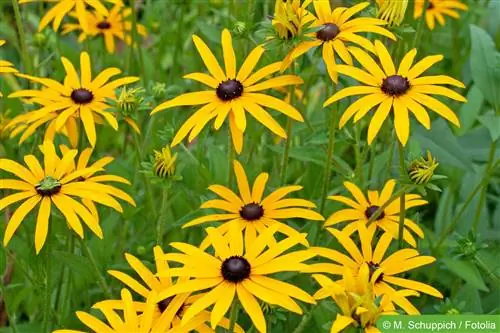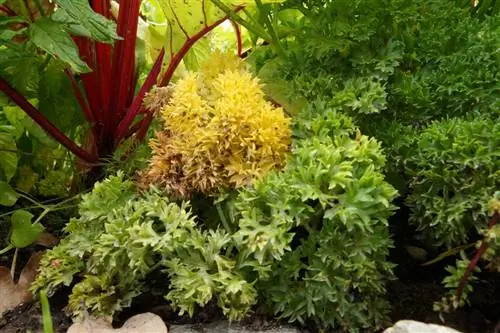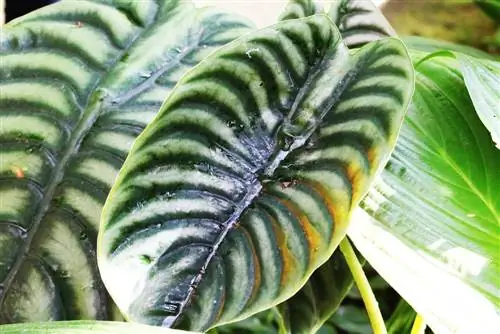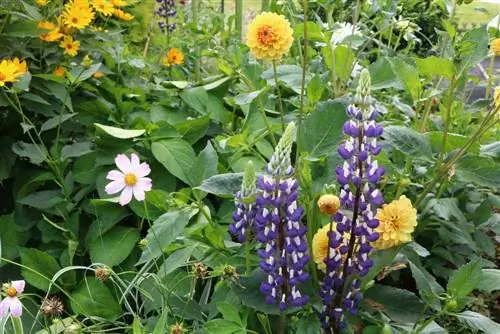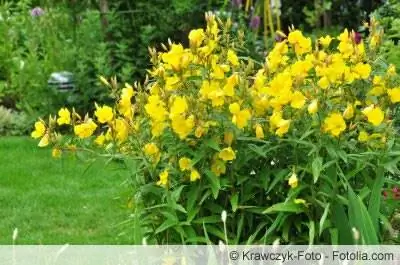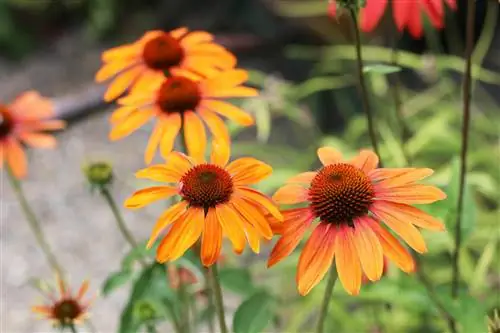- Author admin [email protected].
- Public 2023-12-17 03:39.
- Last modified 2025-01-24 12:45.
The yellow coneflower comes from North America and grows to a height of around 50 to 70 cm. It grows upright, forming densely leafy bushes and foothills. Its leaves are pointed and narrow. The surface of the leaves is hairy and they have a toothed edge. The cup-shaped flower is a deep golden yellow with a round, raised flower center. The petals are arranged in a radial pattern and slope slightly downwards. The yellow coneflower blooms from August to October. The flowers last a very long time in the vase.
Location/Soil
Light intensity has an influence on growth and flowering. The yellow coneflower therefore needs a sunny location with moist, nutrient-rich soil. Alternatively, a partially shaded location is acceptable. The soil should be well-drained. The yellow coneflower cannot tolerate waterlogging. By the way: the yellow coneflower does not bloom in the shade
Tip:
Coneflower also thrives in loamy soil if it is kept moist!
Up to ten flowers develop per plant. The coneflower spreads so densely that weeds almost never come into play. Combine the yellow coneflower with ornamental grasses, in perennial beds, with delphiniums and on borders. Colorful plant partners include veil verbena, phlox and asters. In an exposed location, a group of coneflower perennials forms an eye-catcher that cannot be overlooked.
Sowing
Propagation using seeds from specialist retailers is possible throughout the entire growing season from April to September. The seeds are placed in a deep seed tray or a flower pot with fine, crumbly soil. The seeds must be planted at least 30 cm to 40 cm deep. The seeds are covered with soil and watered. The germination time is two to three weeks. After a short time, the seedling can be placed outdoors. The planting depth and the planting distance for the seeds outdoors are around half a meter.
Tip:
The Goldsturm variety can be propagated particularly well by seeds!
The seeds can be sown on the windowsill or in the greenhouse as early as February. Then the coneflower has a growth advantage over sowing outdoors. You have to wait for the ice saints to release the young plants.
Plants
The perennial grows to a height of 40 cm to 60 cm and a width of 50 cm to 70 cm. This results in a planting distance of between 40 cm and 60 cm per square meter.
Pouring
The yellow coneflower tolerates short dry periods and wet periods. On average, it requires normal soil moisture. It has no special requirements and is best watered in the evening in summer. Did you know? Regular watering extends the flowering period in autumn!
Fertilize
- incorporate compost regularly
- Stimulate growth in spring with mineral fertilizer
- Before flowering, spread complete fertilizer around the perennial and carefully work it into the soil
Care
Withered flowers are cut off with scissors. This increases the attractiveness and promotes the formation of new flowers. The soil around the perennial can be loosened to ensure good permeability. In winter the yellow coneflower is shortened to 15 cm above the ground.
Propagate
Without division, the yellow coneflower spreads quickly. Densely growing perennials can be propagated by division. The perennial is lifted out of the ground with a fork and divided into two or more halves. When digging in, keep a sufficient planting distance and size the planting hole generously so that the coneflower can spread well.
Tip:
Untangle the densely overgrown roots by hand to avoid injury! The coneflower is best propagated in spring by division.
Propagation by cuttings
Alternatively, the yellow coneflower can be propagated through cuttings. To do this, select leaf clusters without flowers and with at least three pairs of leaves. Cut the cutting with a sharp knife and place it around 3 cm deep in potting soil. Water the cutting generously and then keep it moderately moist for six weeks. Enough roots should now have formed so that the cutting can be planted outdoors. Cuttings are particularly easy to propagate in late summer. They grow on the windowsill over the winter and then start in the garden in spring.
Tip:
Don't water the cuttings too much over the winter, but don't let the soil dry out either!
Wintering
The faded stems of the yellow coneflower are cut off a hand's width above the ground in autumn. If you leave the inflorescences standing, you provide food for the garden birds, which pick out the flower seeds. The yellow coneflower overwinters outdoors without winter protection. Its densely branched roots reach deep enough into the earth so that the frost cannot harm them.
Tip:
If you leave the coneflower as an ornament over the winter, then you can cut the perennial back in early spring in February or March.
Diseases
The yellow foxglove can be attacked by leaflets. The leaves then show brown spots and feeding passages. Infected leaves are removed and burned. If the leaflets spread, treatment with an insecticide is indicated. Another disease is powdery mildew caused by a stand that is too dark. By the way: snails don't like coneflowers!
Known varieties
The coneflower is widespread with over 23 species. It grows in America at altitudes of up to 2,800 meters. Very decorative species are:
- Rudbeckia fulgida var. sullivantii 'Goldsturm'
- Rudbeckia lanciniata ‘Goldball’
- Rudbeckia nitida ‘Hersbtsonne’
- Rudbeckia fulgida ‘Rubinstein’
- Rudbeckia fulgida ‘Goldsteinii’
Frequently asked questions
What criteria are there for buying young plants?
They must be compact. Brown leaves are taboo.
How many hours of sunshine does the yellow coneflower need per day?
Six hours of sunshine is optimal.
Is there an extra tip for planting?
A handful of compost in the planting hole promotes growth and covers initial nutrient requirements.
How does the yellow coneflower best show off?
Planted in groups, the perennial produces a sea of yellow flowers.
What you should know about the coneflower in brief
The coneflower is an extremely popular plant from the perennial plant genus. Thanks to their strong yellow color, they are often found as plants in beer gardens. But the coneflower perennial also cuts a fine figure in front gardens. The plant itself includes around 40 different forms, the sizes of which vary greatly. The smallest of its kind grows to just 40 cm high and is therefore ideal for planting in flower pots or containers. The largest of its kind, however, reaches an impressive size of two meters.
Location
- The name “coneflower perennial” already suggests: the plant prefers a sunny and warm location.
- If the perennial is too moist or in the rain a lot, the plant will notice this directly and brownish spots will appear on the petals.
- If the location is nice and sunny and warm again, the brown spots will simply grow out.
- The soil should also be nutrient-rich. Soil rich in humus is ideal.
So that the coneflower is shown to its best advantage, you should plant it next to magnificent perennials. Flame flowers, sage, Indian nettles are ideal here, but also next to buddleia, the coneflower shines in its full beauty and thus offers a wonderful color contrast.
Care
- So that you can enjoy the beauty of the coneflower for a long time, you should remove the spent flowers regularly.
- Also pay attention to diseases that are usually caused by mildew. In such cases, you should quickly take countermeasures.
Propagation
- Take advantage of early spring when the first new shoots appear. However, you can also try growing seeds.
- To cut the coneflower perennial, spring from February to March is ideal.
- As an alternative, you can cut it back after the flowering period. To do this, simply cut it hand-width above the ground.
- If you want to plant new perennials, the distance should be at least 30 cm up to one meter, depending on the type of perennial.

